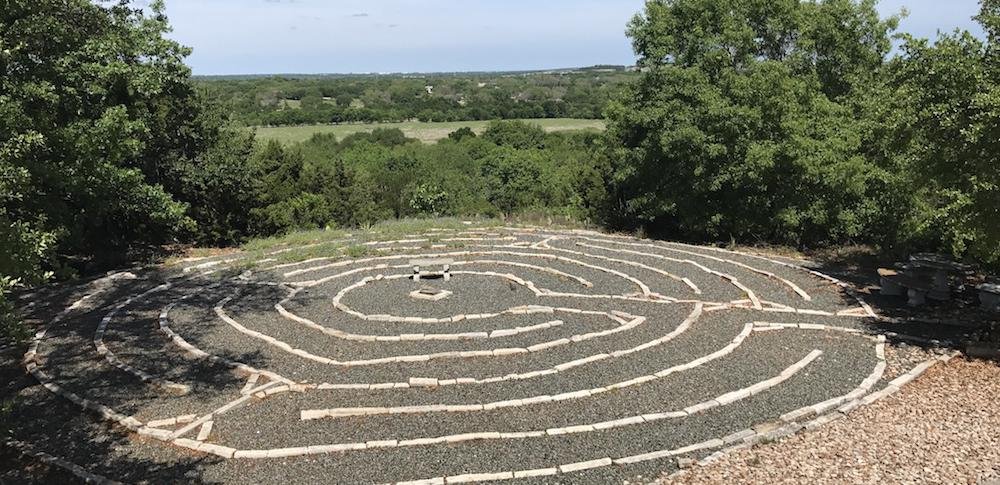
Labyrinth
Tucked away in a quiet corner of our property is our Labyrinth. The Labyrinth symbolizes the journey of life and the path of prayer. The St. Alban’s labyrinth was built using crushed glass and native limestone. The panoramic hilltop view provides a peaceful place for meditation.
What is a Labyrinth?
The labyrinth is an ancient design, known to the human race for over 4,500 years. This archetype, or “divine imprint” is found in many religious traditions in various forms around the world. A metaphor for the spiritual journey, the labyrinth has been a part of the Christian experience from as early as the 4th century, and was a prominent part of numerous cathedrals in Europe dating from the 11th and 12th centuries. Medieval Christians unable to make the long and dangerous pilgrimage to the holy land journeyed instead to the great “pilgrimage” cathedrals, where they walked the winding path of the labyrinth as an expression of devotion and as a way to practice the presence of God. The labyrinth is a walking meditation. It reminds us of the faith journey which others have walked before us. It helps each of us to think about our own life journey, both physical and spiritual. The path takes many turns but there is only one Way. The path can mirror where we are in our lives. In can bring our sorrows and our joys to the surface.
Why Use the Labyrinth?
Jesus calls us to the discipline of prayer, but many people have a difficult time quieting their minds when they sit and pray or meditate. There is sometimes restlessness in the body, which seems to want to move. Walking the labyrinth involves the whole person. Itis like a “body prayer.” There seems to be a natural quieting of the whole person as the labyrinth is walked. Walking on the path helps to keep us focused, something we need in this chaotic and distracting world. It brings mind, body, and spirit into harmony.Walking the labyrinth with other believers reinforces our sense of community - it helps us to see our lives from a perspective of wholeness and correctness. In that sense, it does much to strengthen Christ’s body, the Church.
What Does the Labyrinth Symbolize?
The Labyrinth symbolizes the journey of life and the path of prayer. To grow spiritually and live abundantly, we must let go of certain things, such as judgments and negativity. We let go by walking towards the center with the intention of releasing something. When you sense you might be ready, shake it out, drop it, or release it in any other way that feels right to you. If you still have it when you arrive at the center, offer it to God. As you move out, do not take it with you. After letting go, we must wait silently for illumination as God feeds us with new insight. Then we can go back to our lives, empowered by God to serve him and each other, as he directs.
A Traditional Labyrinth Has Three Stages
The Way In (Purgation)
Time for the traveler to let go of the outside world, to shut out distractions and worries of everyday life. This stage may be to release the old and make room for what is to come - to begin listening - to refresh. Purgation, the first stage, begins when you enter the labyrinth and continues all of the way to the center. To purge means to cleanse, to release, to let go, to empty, to quiet, or to shed. As you take steps into the labyrinth, you may be able to let go of the business and stress of everyday life, things that may make you feel separated from God. Thoughts and feelings from your deeper self may emerge.
The Center (Illumination)
The Center of the labyrinth is a place of meditation and prayer. It is a place of possibility. This stage is for the opening of hearts and for minds to be receptive to our encounter with God. Leave with God those items we no longer want to carry in our hearts and lives. Illumination, the second stage, is your experience as you spend time in the center of the labyrinth. The illuminative time is always in the presence of the Divine. This presence is God’s gift to those who seek God. Walk into the center with an open mind and heart and be prepared to simply receive whatever it is God has for you.
The Way Out (Union)
This is a time when, renewed and strengthened in spirit, we join with the Divine and take what we have found back out into the world,perhaps with a new sense of mission. Union, the third stage, is walking back into the world carrying your experience of God’s presence. During the walk we are encouraged to take on a greater life, God’s life, and we are called to live this greater life in the everyday world
